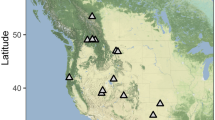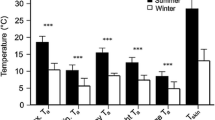Abstract
Bats in hot roosts experience some of the most thermally challenging environments of any endotherms, but little is known about how heat tolerance and evaporative cooling capacity vary among species. We investigated thermoregulation in three sympatric species (Nycteris thebaica, Taphozous mauritianus and Sauromys petrophilus) in a hot, semi-arid environment by measuring body temperature (T b), metabolic rate and evaporative water loss (EWL) at air temperatures (T a) of 10–42 °C. S. petrophilus was highly heterothermic with no clear thermoneutral zone, and exhibited rapid increases in EWL at high T a to a maximum of 23.7 ± 7.4 mg g−1 h−1 at T a ≈ 42 °C, with a concomitant maximum T b of 43.7 ± 1.0 °C. T. mauritianus remained largely normothermic at T as below thermoneutrality and increased EWL to 14.7 ± 1.3 mg g−1 h−1 at T a ≈ 42 °C, with a maximum T b of 42.9 ± 1.6 °C. In N. thebaica, EWL began increasing at lower T a than in either of the other species and reached a maximum of 18.6 ± 2.1 mg g−1 h−1 at T a = 39.4 °C, with comparatively high maximum T b values of 45.0 ± 0.9 °C. Under the conditions of our study, N. thebaica was considerably less heat tolerant than the other two species. Among seven species of bats for which data on T b as well as roost temperatures in comparison to outside T a are available, we found limited evidence for a correlation between overall heat tolerance and the extent to which roosts are buffered from high T a.





Similar content being viewed by others
References
Baker WC, Pouchot JF (1983) The measurement of gas flow. Part II. J Air Pollut Control Assoc 33:156–162
Bakken GS (1992) Measurement and application of operative and standard operative temperatures. Am Zool 32:194–216
Bininda-Emonds ORP et al (2007) The delayed rise of present-day mammals. Nature 446:507–512
Blomberg SP, Garland T, Ives AR (2003) Testing for phylogenetic signal in comparative data: behavioral traits are more labile. Evolution 57:717–745
Bronner GN, Maloney SK, Buffenstein R (1999) Survival tactics within thermally challenging roosts: heat tolerance and cold sensitivity in the Angolan free-tailed bat, Mops condylurus. S Afr J Zool 34:1–10
Calder WA (1996) Size, function and life history. Dover Publications, Mineola
Cannon B, Nedergaard J (2004) Brown adipose tissue: function and physiological significance. Physiol Rev 84:277–359
Cooper CE, Withers PC (2009) Effects of measurement duration on the determination of basal metabolic rate and evaporative water loss of small marsupials: how long is long enough? Physiol Biochem Zool 82:438–446
Dawson TJ, Schmidt-Nielsen K (1966) Effect of thermal conductance on water economy in the antelope jack rabbit, Lepus alleni. J Cell Physiol 67:463–472
Dawson WR, Whittow GC (2000) Regulation of body temperature. In: Sturkie PD (ed) Avian physiology. Academic Press, New York, pp 343–390
Garland T, Ives AR (2000) Using the past to predict the present: confidence intervals for regression equations in phylogenetic comparative methods. Am Natur 155:346–364
Geiser F, Brigham RM (2000) Torpor, thermal biology, and energetics in Australian long-eared bats (Nyctophilus). J Comp Physiol B 170:153–162
Genoud M, Christe P (2011) Thermal energetics and torpor in the common pipistrelle bat, Pipistrellus pipistrellus (Vespertilionidae: mammalia). Compar Biochem Physiol A 160:252–259
Gordon MS, Olson EC (1995) Invasions of the land: the transitions of organisms from aquatic to terrestrial life. Columbia University Press, New York
Gorman ML, Brown CR, Bernard RTF (1991) Validation of subcutaneous temperature as a measure of deep body temperature in small bats. J Zool 224:315–318
Henshaw RE, Folk GE (1966) Relation of thermoregulation to seasonally changing microclimate in two species of bats (Myotis lucifugus and M. sodalis). Physiol Zool 39:223–236
Herreid CF (1967) Temperature regulation, temperature preference and tolerance, and metabolism of young and adult free-tailed bats. Physiol Zool 40:1–22
Herreid CF, Schmidt-Nielsen K (1966) Oxygen consumption, temperature, and water loss in bats from different environments. Am J Physiol 211:1108–1112
IPCC (2011) Intergovernmental panel on climate change special report on managing the risks of extreme events and disasters to advance climate change adaptation. Cambridge University Press, Cambridge
King JR, Farner DS (1961) Energy metabolism, thermoregulation and body temperature. In: Marshall AJ (ed) Biology and comparative physiology of birds, vol 2. Academic Press, New York, pp 215–288
Kurta A (1986) Factors affecting the resting and postflight body temperature of little brown bats, Myotis lucifugus. Physiol Zool 59:429–438
Lasiewski RC, Acosta AL, Bernstein MH (1966) Evaporative water loss in birds, I. Characteristics of the open flow method of determination, and their relation to estimates of thermoregulatory ability. Comp Biochem Physiol 19:445–457
Lavin SR, Karasov WH, Ives AR, Middleton KM, Garland T (2008) Morphometrics of the avian small intestine compared with that of nonflying mammals: a phylogenetic approach. Physiol Biochem Zool 81:526–550
Licht P, Leitner P (1967a) Behavioural responses to high temperatures in three species of California bats. J Mammal 48:52–61
Licht P, Leitner P (1967b) Physiological responses to high environmental temperatures in three species of microchiropteran bats. Comp Biochem Physiol 22:371–387
Lighton JRB (2008) Measuring metabolic rates: a manual for scientists. Oxford University Press, Oxford
Maddison WP, Maddison DR (2011) Mesquite: a modular system for evolutionary analysis. Version 2.75. http://mesquiteproject.org
Maloney SK, Bronner GN, Buffenstein R (1999) Thermoregulation in the Angolan free-tailed bat Mops condylurus : a small mammal that uses hot roosts. Physiol Biochem Zool 72:385–396
Marom S, Korine C, Wojciechowski M, Tracy CR, Pinshow B (2006) Energy metabolism and evaporative water loss in the European free-tailed bat and Hemprich’s long-eared bat (Microchiroptera): species sympatric in the Negev Desert. Physiol Biochem Zool 79:944–956
McKechnie AE, Wolf BO (2010) Climate change increases the likelihood of catastrophic avian mortality events during extreme heat waves. Biol Lett 6:253–256
Norberg UM, Rayner JMV (1987) Ecological morphology and flight in bats (Mammalia; Chiroptera): wing adaptations, flight performance, foraging strategy and echolocation. Philos Trans Royal Soc London B 316:335–427
Rothwell NJ, Stock MJ (1985) Biological distribution and significance of brown adipose tissue. Compar Biochem Physiol A 82:745–751
Schmidt-Nielsen K (1984) Scaling: why is animal size so important?. Cambridge University Press, Cambridge
Scholander PF, Hock R, Walters V, Johnson F, Irving L (1950) Heat regulation in some Arctic and tropical mammals and birds. Biol Bull 99:237–258
Studier EH (1970) Evaporative water loss in bats. Comp Biochem Physiol 35:935–943
Studier EH, Proctor JW, Howell DJ (1970) Diurnal body weight loss and tolerance of weight loss in five species of Myotis. J Mammal 51:302–309
Swanson DL, Garland T (2009) The evolution of high summit metabolism and cold tolerance in birds and its impact on present-day distributions. Evolution 63:184–194
Thomas SP, Suthers RA (1972) The physiology and energetics of bat flight. J Exp Biol 57:317–335
Walsberg GE, Wolf BO (1995) Variation in the respirometry quotient of birds and implications for indirect calorimetry using measurements of carbon dioxide production. J Exp Biol 198:213–219
Welbergen JA, Klose SM, Markus N, Eby P (2008) Climate change and the effects of temperature extremes on Australian flying-foxes. Proc Royal Soc B 275:419–425
Willis CKR, Brigham RM (2003) Defining torpor in free-ranging bats: experimental evaluation of external temperature-sensitive radiotransmitters and the concept of active temperature. J Comp Physiol B 173:379–389
Willis CKR, Turbill C, Geiser F (2005) Torpor and thermal energetics in a tiny Australian vespertilionid, the little forest bat (Vespadelus vulturnus). J Comp Physiol B 175:479–486
Wimsatt WA (1970) Biology of bats. Academic Press, New York
Withers PC (1992) Comparative animal physiology. Saunders College Publishing, Fort Worth
Acknowledgments
We thank Peter and Jane Phillips for allowing us to conduct this project on Makulu Makete, and for all their support and encouragement. We also thank the following field assistants: Treharne Drury, Veronique Wolfaardt, Phillip Crawford, Cedric and Yvonne Cory Toussaint, Nancy and Dean Barber and Philip Jordaan. Berry Pinshow and two anonymous reviewers provided constructive comments that greatly improved the quality of the manuscript. This study was facilitated by funding from Bat Conservation International, the National Research Foundation and the University of Pretoria. All experimental procedures were approved by the University of Pretoria’s Animal Use and Care Committee (Project EC014-10) and comply with current South African laws.
Author information
Authors and Affiliations
Corresponding author
Additional information
Communicated by I.D. Hume.
Electronic supplementary material
Below is the link to the electronic supplementary material.
Rights and permissions
About this article
Cite this article
Cory Toussaint, D., McKechnie, A.E. Interspecific variation in thermoregulation among three sympatric bats inhabiting a hot, semi-arid environment. J Comp Physiol B 182, 1129–1140 (2012). https://doi.org/10.1007/s00360-012-0683-6
Received:
Revised:
Accepted:
Published:
Issue Date:
DOI: https://doi.org/10.1007/s00360-012-0683-6




